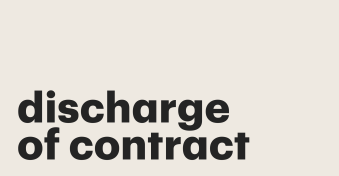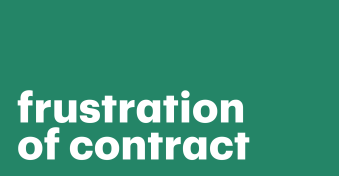Imagine a company intending to partner with a service provider on a long-term basis.
The two parties negotiate a deal; the company is well aware of the service quality the vendor provides but has various concerns about further cooperation and the risks it brings:
- What if the provider increases the prices unexpectedly, and at a particularly bad time for the customer?
- What about the guarantees?
- What if the customer is unable to pay for the service for some reason?
- And what if the vendor is unable to deliver the service on time or fails altogether?
With these possible scenarios in mind, both eventually find themselves unable to agree on crucial clauses of the contract.
They have two ways of dealing with this — either break the deal or move forward by executing a contingent contract.
Let’s study the question and define what a contingent contract is, review its usage, detail pros and cons, and explore nuances of the negotiations under contingent contracts.
Key takeaways
- A contingent contract means a contract with certain conditions triggering its entry into force.
- There are a variety of contingency types that can be included in contingent contracts. Because of their widespread popularity among business domains, this makes such contracts challenging in terms of negotiation.
- Despite people often using contingent and conditional contracts as synonymous terms, a conditional contract is a much broader term, including contingent contracts, as well.
- The main advantages of contingent contracts are the well-balanced interests of both parties, powerful leverage for risk mitigation, as well as fewer renegotiations and lawsuits.
- These contracts, however, have some disadvantages: often unequal access to the information helping to negotiate for different parties, insufficient criteria for measuring the contingent condition occurrence, and high demand for negotiations before signing.
- Rule of thumb: the contingency clauses must comply with actual laws and regulations, have clear and specific terms, be reasonable, agreed upon mutually, and in good faith of all the involved parties, as well as shouldn’t ever promote unethical behavior.
What is a contingent contract?
A contingency means the contract terms are not absolute — they are tied to conditional actions and events that will determine specific outcomes.
That’s basically the core formula describing the features of a contingent contract:
If something happens or doesn’t happen (a future event), then a resulting thing happens because of that event (the agreement comes into force and parties fulfill the obligations).
So the contract comes into action when a certain event specified here either occurs or doesn’t occur, enabling the parties to fulfill their obligations.
On one hand, a contingent contract is based on the absolute commitment of the parties to do what the document says.
At the same time, the agreement is conditional since the counterparties are obliged to fulfill the commitment only if a certain event does or does not take place in the future.
Contingent vs. conditional contract
Contingent and conditional contracts are often used interchangeably. But they’re slightly different.
A conditional contract is a more general term meaning any contract containing one or more conditions that must be fulfilled for the contract to be fully binding.
Simply put, all contingent contracts are conditional ones but not all conditional contracts are contingent ones.
The conditions in a conditional contract can be classified as precedent, subsequent, or concurrent:
- Precedent is a condition that must be satisfied before one or both parties are obligated to perform under the contract.
- Subsequent is a condition that terminates an existing obligation under the contract, when it occurs or fails to occur, depending on what is mentioned in the agreement.
- Concurrent is a condition that must be satisfied by both parties simultaneously for the contract to be fully binding.
Universal constraints for contingent contracts
Below you can find some general principles and constraints across various industries when using contingent contracts.
However, specific industries or business sectors may have additional regulations and ethical standards you should take into account.
Legality
The terms of the contingent offers must comply with existing laws and regulations.
Contracts that involve illegal components or activities are generally unenforceable.
Clarity and specificity
Contingent contracts should have clear and specific terms to avoid misunderstandings and disputes.
All the parties must clearly understand the conditions, obligations, and benefits of a contract.
Reasonableness
The terms of a contingent contract should be reasonable.
Overly burdensome, unfair, or oppressive terms could lead to deeming the contract unenforceable.
Mutual consent and capacity
All parties involved in a contingent contract must mutually agree to the terms and enter into the contract voluntarily.
Additionally, all parties must have the legal capacity (be of a certain age and have the mental capacity to understand the terms and implications) to enter into a contract.
Good faith
The parties involved in a contingent contract should act in good faith and not attempt to deceive or manipulate one another.
While ethical considerations aren’t always legally required, it is important to consider them, too.
The contract should not promote unethical behavior or create incentives that may compromise the quality of goods or services.
Contingent contract examples and use cases
These contracts are applicable in various situations, from employment to bank guarantees, and can be used by businesses operating in a wide range of industries.
You should carefully choose a contract management software for your company which should have a sufficient collection of contract templates covering your business niche and an efficient tool for generating ready-made documents.
Below are some common examples of different types of contingent contracts and use cases for selected business domains.
Professional services
Let’s say a company wants to promote its product and needs professional services — in this case, five custom-made videos for this purpose.
They meet with the video production studio they’re considering as a contractor, and they aren’t quite sure if the company complies with the budget, deadlines, and quality level they need.
They can sign a purchase agreement with the production company covering just the first video as a test and then make another agreement for the rest if the first one works out.
But that would be harder in operational terms, as well as would likely be more expensive than in bulk.
Also, the production company is always looking to grow and might update its price list sooner than the second agreement is signed.
What they can do is make these issues contingent: if the client is satisfied with the result, then they continue working together at a 5-video pack price.
If not, then the client pays full price for just one video and they close the deal as such.
Custom software development
A company develops custom software for a startup.
That’s a long-term project which might change and scale up as the client’s business rapidly evolves.
It might get more time and resource-consuming, as well as morph into something far from the initial business goals.
To avoid relevant risks of financial losses or even failed project delivery, the development company can make some clauses contingent.
For instance, setting a milestone-based payment: the payments to the contractor are contingent and must be issued only upon successful completion of project milestones predefined in the contract.
Should the project scope increase, having milestones in place guarantees the startup receives completed work in a timely manner, and the software company knows they’re getting paid on time.
Insurance
For insurance companies, the contingent contract is the main type of agreement they sign with clients.
The general condition is that the compensation of the client’s expenses will only occur in case of an uncertain event covered by the contract and upon recognizing this event as an insurance case.
Banking and financial services
Apart from the most obvious money lender agreements, imagine a three-party agreement between the bank, the service provider, and the customer (who in turn is the bank’s client).
In this case, the provider serves the customer, and the bank is a guarantor to reimburse the costs to the vendor in case the customer fails to pay for the service.
Such type of a contract is called a contingent guarantee contract.
An indemnity contract works in a slightly different way.
For instance, imagine there’s a supplier obliged to deliver a product to the customer.
In case the supplier fails to deliver the product, the indemnifier (compensator, which is the bank here) offers compensation to the customer for damages and losses due to the supplier’s neglect or default on delivery.
Job negotiations and employment
What about hiring? Contingent contracts in the employment process are more of an exception than a common practice.
Despite that, they can give both parties certain flexibility and guarantees at the same time. Let’s look at an example.
A junior DevOps engineer is working in their existing occupation for a fair amount of time and is eager to get promoted.
The employee doesn’t really understand why they aren’t experiencing any career growth after working hard for so long.
Their unit manager says the recent performance assessment shows insufficient results for promotion.
The manager is not wrong — but the employee had no clue there was any criteria and feels manipulated and misguided.
Adding clauses to the contract from the beginning that clearly define criteria to be met is a way to avoid such situations.
Specify a certain amount of months or years of experience, set the performance level the employee must steadily achieve, or list certain operations they must master.
Precise criteria in the above example would serve as a guarantee to the employee that the manager does not downgrade their progress when it comes to negotiating promotion.
Clauses that may be contingent in such a contract could reference salary, position, responsibilities, job sharing, flextime, and everything the parties should be clear about.
Of course, these clauses must always comply with local and federal labor laws.
Healthcare
Contingent contracts are applied for healthcare, too. Usually, they’re more common for dealing with providers, not patients.
For example, a hospital needs a new MRI machine.
The contingent contract, in this case, might specify that 50% of the total payment is due upon successful MRI machine installation, and the remaining 50% is due after the MRI machine has been operational for a certain period without any significant issues (i.e., 30 days).
With respect to patients, contingent clauses may be tied to treatment outcomes, adherence to treatment plans, or participation in health management programs.
For instance, if a patient agrees to follow the prescribed treatment plan.
And the hospital’s ongoing support and services might be contingent upon the patient’s adherence to the treatment plan, with the penalties for non-adherence like loss of benefits or exclusion from the treatment program.
It’s worth mentioning that contingent contracts are generally legal and enforceable, as long as the conditions are clear, reasonable, and don’t violate any laws or public policy.
However, there are several special limitations that exist when we speak about patient contingent contracts:
- Such contracts should respect patients’ rights to make informed decisions about their healthcare.
- Healthcare providers have an ethical responsibility to act in the best interests of their patients.
- Contingent contracts that involve sharing personal health information must comply with applicable privacy and data protection laws like HIPAA in the USA.
- These contracts should not discriminate against patients based on factors such as age, gender, race, or socioeconomic status.
Education
An example of a contingent contract could be an agreement between a student and an educational institution.
- If the student fails to reach certain academic excellence or to comply with scheduled attendance requirements and/or campus rules, the institution might expel the student from the university or impose other penalties.
- And vice versa — if the student reaches or exceeds a certain level of academic excellence, they can qualify for a grant to cover a part of their tuition fee or for other bonuses specified in the agreement.
Advantages and disadvantages of contingent contracts
While contingent contracts are a must for certain industries (like insurance), this approach is not always emphasized as much in other industries.
The underlying reason or reasons vary, and are reflected in evaluating the balance of pros and cons across different industries.
Let’s review the advantages and disadvantages of contingent contracts.
You must always take them into account when deciding to go the route of using a contingent contract.
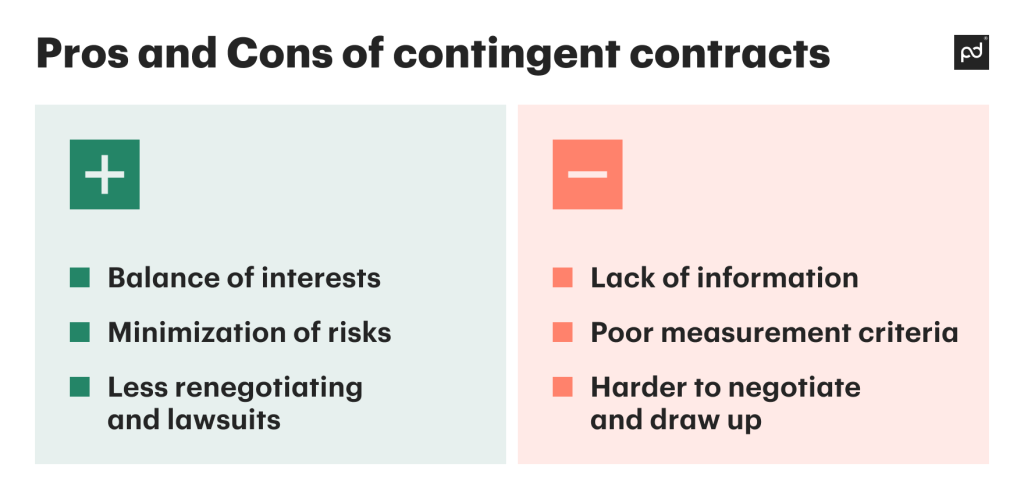
Pros
Balance of interests
Different visions of the future the partners might have doesn’t mean there’s no chance to cooperate.
Moreover, differences and misunderstandings are the core of contingent contracting.
A contingency contact addresses the interests of both parties by allowing them to sort of “bet” on their predictions.
Minimization of risks
If the uncertainty and insecurity of the future prevented each business from partnering we wouldn’t have the great products and services we have today.
Contingent contracting is a tool to minimize risks by postponing the obligations in a way, until future conditions become more definite.
For example, a business investor can’t go all-in and spend everything they have for a promising yet emerging startup.
But the investor can make a small investment and then invest more if it pays off.
The startup team, in their turn, can rely on future investments in case their business takes off.
Less renegotiating and lawsuits
Regular contracts basically give no wiggle room for any surprises the future holds.
When contingencies occur under an absolute contract, it often needs to be revised by making adjustments or sub-agreements.
Unforeseen events often result in conflicts which might lead to litigations.
Contingent contracts reduce the probability of conflicts and describe precisely what happens in case of a conflict.
Cons
Lack of information
One of the parties can have access to valuable information that the other party doesn’t have — and can leverage that knowledge to make more accurate predictions.
For instance, a film producer wants to sell the rights to their movie to a streaming platform.
The acquirers of films and series for this platform have better insight into the ratings of the content they publish and therefore know the preferences of their audience better.
In this scenario, the producer may underrate the potential of their masterpiece and agree to a bad bargain in the transfer of the rights.
Poor measurement criteria
A lack of details describing the event in the agreement can cause misunderstandings about what precisely should be considered a trigger for the parties to fulfill their obligations.
Which audience ratings can qualify as successful for a film? What are the precise academic results a student needs to show to win a scholarship?
What exactly is considered an insured event for a guarantor to reimburse the costs? Specifics are essential; lack of clarity is the enemy here.
Harder to negotiate and draw up
The more misunderstandings there are between the parties, the more time and negotiation the contract requires, the more terms and conditions need to be defined, and the more precise details should be described in a contingency contract.
Negotiations under contingent contracts
Contract management negotiations are quite complex and often challenging for both parties.
However, guiding negotiations efficiently will result in achieving successful outcomes, as well as in balancing the interests of all parties involved.
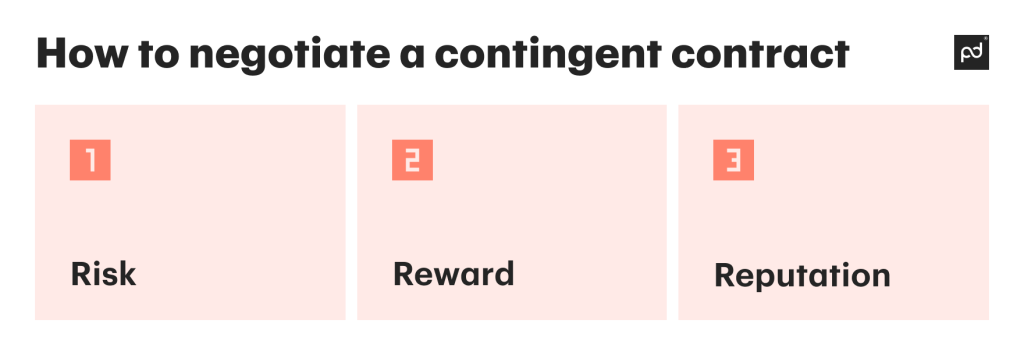
Risk
The level of risk you’re willing to accept when making a conditional deal is the #1 factor in contingent contract negotiating.
In general, the higher the level of risk you’re ready to accept on your side, the lower price you can bargain for.
Probability of the event risk
Estimating the probability an event occurring can help parties evaluate the potential risks associated with the contract.
A higher probability event may lead to a higher perceived risk, which can affect negotiation strategies, contract pricing and valuation, dispute resolution, and even the decision-making itself on whether to enter into the agreement.
Time and resources
Whatever vendor you choose, the risk of extra time and resource spending, including your own, is unavoidable.
It’s usually a matter of the second party’s fairness, level of their expertise, and how well their processes are streamlined.
Don’t be too quick to trust those who tend to offer large scopes of work for suspiciously low prices and with super-fast delivery.
Learn the common practices in the industry, compare the budgets and timelines from different vendors, and ask your vendor about the most frequent problems and pitfalls which might arise during production.
For vendors, it’s important to understand the level of commitment the client can provide when your work is somehow blocked and needs the second party’s involvement.
The more the buyer will be involved, the more efficient your work will be.
Appraisal contingency
An appraisal contingency is a clause commonly included in real estate contracts.
It provides a legal way for the buyer to back out of the purchase agreement if the appraised value of the property is lower than the agreed-upon purchase price.
This approach is most commonly associated with the real estate market, but could be used elsewhere.
The fundamental concept of an appraisal contingency — the contract execution is dependent upon the valuation of an asset — could be applied in other industries (fine art, a classic automobile, etc.).
Reward
Contingency fee
Both hourly-based and fixed-priced payment models are risky in their own way in terms of profitability.
The first one can lead to unexpected growth of both time and cost once significant issues arise or estimations are deemed inaccurate.
The latter, fixed-price, translates to much lower actual pay for the provider in case of scope creep or when serious issues occur and need to be resolved.
A contingency fee is a form of compensation paid only in the case of achieving a certain success specified in the contract.
This fee is based on the potential aid that one party can bring to another.
For buyers, the better you can arrange working conditions for the seller and set everything to maximize their performance, the lower the fee you can negotiate.
For sellers, the fee highly correlates with the overall value of their services for the buyer’s business.
Simply put, it’s easy to sell the $100 project for $1,000 when your customer is clearly aware they will save or get an extra $100,000 as a result.
Some cases require a buying party to escrow earnest money or contingency fees with the third party before the contract execution starts and keep during the time the contract is in force.
For instance, it’s a popular practice in real estate contracts and agreements with law firms.
Incentives and penalties
Sometimes only a part of the total reward upon the contract is based on events occurring.
This means that the reward is divided into the basic part, which will be paid regardless of any further events, and the bonus part, which will be paid or provided (meaning the bonus could be monetary in nature or via specific benefits) only in the case of a condition (or conditions) occurring.
This bonus part is called an incentive.
Examples of incentives include:
- bonus for completing the project ahead of schedule;
- a SDR’s monetary bonus for achieving certain target performance;
- future contract guarantee after the successful completion of the previous one.
In other situations, the second part of the “reward” may not be a bonus at all, and in fact equal zero (or worse) in cases where failure to meet conditions equates to certain financial losses.
This negative fee is called a penalty.
Examples of penalties include:
- monetary damages accrued for each day construction is delayed beyond the agreed-upon completion date;
- the financial penalty a supplier pays for missing the deadlines of supply;
- similar penalty a software development company pays for delivering quality or performance lower than stated in the contract.
Both of these factors — incentives and penalties — are aimed at encouraging parties to perform their contractual obligations, minimize the risk of non-completion or delivering products of subpar quality, and provide compensation for any negative consequences resulting from breaches or underperformance.
When designing incentives and penalties, it is crucial to ensure that they are reasonable, proportional, and legally enforceable.
And sometimes it is better to allocate incentives in a separate agreement.
This option works well when other parties shouldn’t know the amount of incentives or its very existence, or there are different legal conditions for incentive beneficiaries and other parties.
Reputation
Current reputation is a strong factor when it comes to negotiating and decision-making.
The esteemed reputation one party has can help them secure a better price and increase their chances of successfully signing an agreement.
Conversely, if their reputation is low, it usually leads the second party to adjust pricing or even break the negotiations.
For the buyer’s reputation, the time costs much more than the price.
This means if you secured a low price on the contract with a vendor but the time to get the project completed is stretched far beyond planned, this will likely damage your reputation among the people awaiting the release of your product.
The flip side?
Nobody will know that you paid a higher price on a contract when a project is completed on time — they’ll just be satisfied consumers, and there’s a lot of value in that.
Notes on the margins for those who craft contingent contracts
How do you approach adding contingencies in the contract in order to make everything right?
We have some important aspects you shouldn’t overlook during your document preparation.
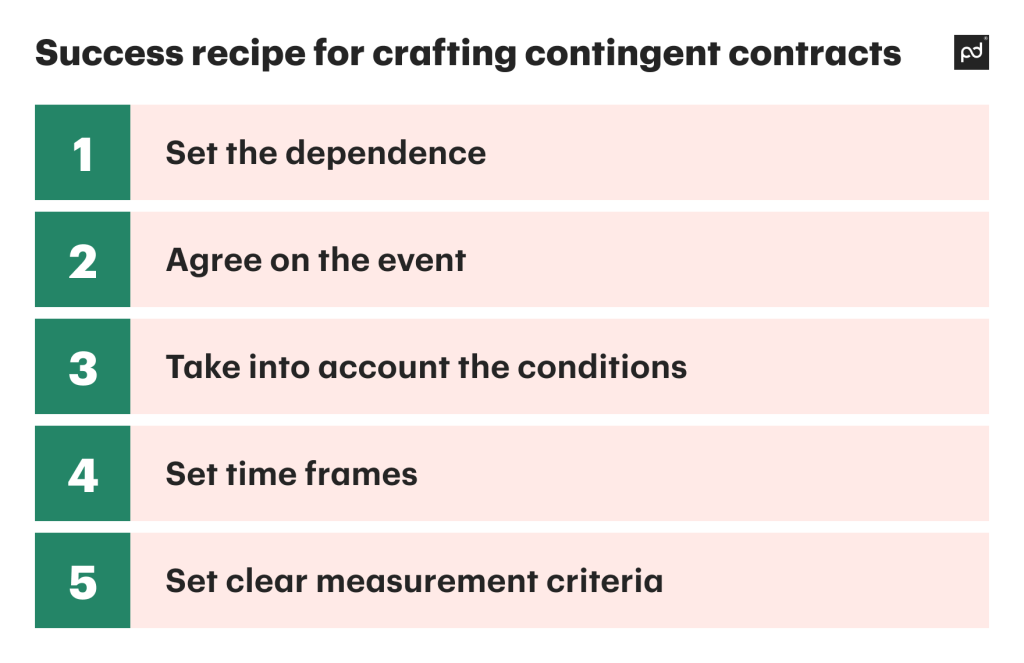
Set the dependence of the contract performance
The agreement comes into force, i.e. the parties are obliged to do or not to do something, if a certain event in the future occurs or doesn’t occur.
This means the contract can’t be enforced unless and until the specified event happens or doesn’t happen.
Agree on the event that triggers the enforcement of the contract
The contingent contract can be based on an event that is supposed to either happen or not happen.
The event must be reasonable and able to occur in reality, can be either subsequent or precedent, and qualify as enforceable in case the signees can’t influence it.
Take into account the conditions for voiding the contract
The contract might become void in two general cases.
First, if there are force majeure circumstances or actions that make the event specified in the contract impossible (like a natural disaster, or death of one of the parties).
And second, if the contract is based on the way a person is supposed to act in the future, but, in reality, that person’s actions prevent them from adhering to the contract requirements.
Set time frames
Set time frames during which an offering party must agree to the condition before the offer expires.
In case there’s a specific time period for the event to happen or not happen, the contract becomes valid once the timeline is met.
Set clear measurement criteria
Decide how the terms of the contract will be measured and set clear measurement criteria (precise numbers, percentages, rates, dates, etc.)
Streamline drafting your contingent contracts with PandaDoc
Contingent contracts are contracts where enforcement is based on certain conditions.
Such an agreement type is applicable when some of the aspects of the unfolding deal aren’t evident at the time negotiations take place.
The most illustrative example is an insurance agreement where the contract execution is always triggered by the occurrence of the insured event.
Alongside that industry, such agreements are also applicable to professional services, custom software development, banking, financial services, job employment, healthcare, education, and many other business domains.
Contingent contract negotiation isn’t always an easy process for sure.
But doing so helps avoid much less pleasant consequences than standard agreements can cause in the same situations.
We are here to help you make the process of contract creation, negotiation, and signing much easier and faster, reduce errors, and raise the cost-effectiveness of your contract management department.
Schedule a free demo or sign up for a free 14-day trial to get all the helpful features PandaDoc offers firsthand.
Disclaimer
PandaDoc is not a law firm, or a substitute for an attorney or law firm. This page is not intended to and does not provide legal advice. Should you have legal questions on the validity of e-signatures or digital signatures and the enforceability thereof, please consult with an attorney or law firm. Use of PandaDocs services are governed by our Terms of Use and Privacy Policy.
